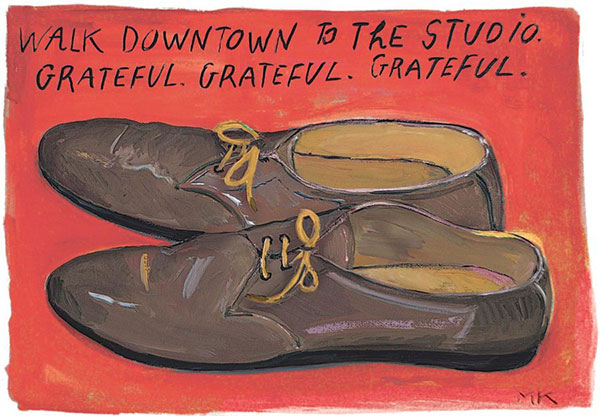Three Pieces of Advice for the Creative Life
Last month, I received an honorary doctorate and gave the commencement address at ArtCenter College of Design in Pasadena, California. Founded in 1930, the school prides itself on being a cutting-edge institution — a place that takes a conservatory-like approach to teaching people how to be fearlessly creative and have a definitive impact on the world. It was challenging to think of what to tell a group of artists with such wide-ranging expertise and aspirations (there are 11 undergraduate and 7 graduate degrees in everything from illustration to transportation design). Ultimately, I decided to just talk about the challenge and gift of making art — whatever the motivation, whatever the medium. And, unsurprisingly, I drew on the wisdom of my friend and mentor Parker Palmer. I hope it’s useful to you:
I want to start by letting you all close your eyes and take a 30-second nap. Kidding. Kind of. I’m sure you are beyond exhausted after driving toward finishing these final projects — which were AMAZING. I can’t tell you how much I enjoyed seeing them and learning from you over the last couple of days.
You should be so proud. Proud of yourself. Proud of one another. I know your friends and family who are here must be powerfully moved by who you are becoming in this moment, the vocation you have committed to, the passion that you bring to that choice every single day. Thank you to them for having the wisdom to support you in what might not always feel like a familiar or safe field. I know my parents always said, “Follow your bliss!” And then when my brother became an experimental poet, and I became a writer, they were like, “Oh wow, that’s a lot of bliss!” We hear you parents, we hear you family, and we got this.
There is real genius and collaboration afoot here. It’s so exciting to witness, especially right now.
We live in an era of chaos — personally and professionally. All of our institutions are crumbling and being remade. Whatever career paths there ever were for designers and artists have been carved into a thousand little tributaries. In some ways power has been decentralized; the connection between your art and your audience has never been so direct. That’s thrilling. There has probably never been a time when designers were so in demand or so understood.
On the other hand, economic constraints are brutal. The cost of housing, not to mention studio space, is out of pace with real wages. What little federal funding there was for artists is threatened by a presidency that undervalues curiosity, nuance, vulnerability — all the things that make art great.
In other words, the best of times and the worst of times. (Maybe a little worse even.)
One of my dearest mentors is a Quaker writer in his seventh decade named Parker Palmer. He is not a fancy guy. He is from Wisconsin and loves a stupid pun. He could care less about what gallery you are represented by or what company you design products for. He just wants to know if you are kind, what has broken your heart, and if you’ve managed to make art about it.
He often talks about what it takes for sensitive humans to stand in the “tragic gap.” By this he means, “the gap between the hard realities around us and what we know is possible — not because we wish it were so, but because we’ve seen it with our own eyes.”
I stand here today within a San Andreas Fault of tragic gaps. I’m going to tell you about just three.
First, there’s the gap between how I imagine a book might get written and how I actually write it.
In my imagination, there are file folders — both physical and digital, a beautifully orchestrated system of research and reporting, all the time in the world to read and re-read the interviews and analyze where the patterns are, plenty of time for revision.
In reality, there is me, typing fast while hiding from my children, shivering in the second floor of a decrepit barn, surrounded by band equipment and a tennis racket stringer. The file folders are in various states of disarray with strange names — as if I am not one, but twelve people who all earnestly started a system they believed would finally get the rest of us in line.
There are those of you who will make art from here on out in beautifully organized, light-filled studios with all the time in the world. Congratulations. Enjoy every silent minute and ray of light. I mean it.
But for most of us, the reality of art-making is much less glamorous. If your process is untidy, if it is done in defensive crouches in between making money or wiping butts, please know that you are not alone. And not any less of an artist. Your life is the raw material from which you make art, so if you have less studio time and space, but lots of life, consider yourself filthy rich with material.
Second and related, there’s the tragic gap between how I think creating is supposed to feel and how it actually feels.
Now listen, I’m not one of those people who likes to make writing sound like some noble torture. It’s work. It requires diligence and deadlines. Sometimes it flows. Often it doesn’t. And when it doesn’t, it can feel bewildering. At least a few times a year I ask myself (and usually a dear friend and fellow artist): Is this unmoored, self-loathing part of the creative process, the storm before the breakthrough? Or does the shitty feeling mean I’m making shitty art?
The making of art rarely feels as good as you wish it would; the product of that making never as satisfying. Which is why you can make art for yourself — I always say I write the books I need to read — but you sure as hell better make art for other people, too. They are the ones, ultimately, that really get to revel in the product. To you, it will always be an embarrassingly imperfect thing, a thing you could start over and make entirely differently with what you’ve learned, if only you had a crack at it again. But at some point you have to be finished, or perhaps more accurately, surrender.
I’m guessing many of you just surrendered to your final projects. You get it.
Third and last, there’s the gap between the art I want to make and the art I actually make.
This one is easily measured by the dozens of unintelligible notes I’ve written while nursing or riding the train or squinting at the bright light of my phone in the middle of the night. This is an actual sample:
Hierarchy of love is the root of all evil? Freedom from denial. My mad grandmother. You’re wrong and I love you.
I am amused, but also genuinely heartbroken that I haven’t a clue what any of that means and, for one brief moment, I thought those words were gold.
It’s hellishly hard to pin the insights down — slippery little suckers. Sometimes I have to notice the same pattern of feeling over and over until I can finally register it strongly enough that I realize what it is begging to become.
Sometimes I don’t even realize the pattern is coalescing inside of me. I’ll sit down with a blank Microsoft word doc and a pending deadline and I’ll hope to God something worthwhile comes out. An hour later, I’ll be literally shocked that those 750 words were waiting to be heard. I had no idea, no consciousness of it.
I feel, in those moments, like a mysterious vessel. Like a child, marveling at how much I don’t understand. Playful. Trusting. The best kind of confused. The kind of confused that tells me there are forces at work in this universe that I have no control over nor capacity to understand. But I am a part of it. If I show up and let myself be.
It’s the best feeling in the world. It’s also the rare exception to a whole life of making art bumbling and resisting and doubting myself. But those moments won’t happen if I don’t sit my ass in the chair. Despite the chaos. Despite the dishes. Despite the voice in my head that says that I’m doing it all wrong, that it could have been better, that no one cares.
You have to sit directly in the tragic gaps and trust that God will come through. Or if not God, quantum entanglements. Or if not quantum entanglements, your own subconscious — sacred, maladjusted, pattern-keeping perfection.
It’s as simple and as complex as that. You’re the only you that’s ever been. Keep showing up despite the chaos. Be humble in the pursuit of your art and ruthless about finding the time to make it. Find friends with whom you can weather the tragic gaps. Give one another loving, honest feedback and teach each other how to make money in weird, sustaining ways. Collaborate and commiserate. Make relationships that are reciprocal, not transactional. Make lives that aren’t easy, but rife with good material. Make art that matters.
This is the charge. And it’s a holy one in these times of so much frightening hollowness and fertile upheaval. It is artists, it is you, that we need most to interpret this moment and mirror it back. It is artists, it is you, that we need most to pierce through the bullshit and say it plain. It is artists, it is you, that we need to create pictures of the world, or hell, create the world itself, that we know is possible. You have seen it with your own eyes, if only in your mind’s eye. Help us see it, too. Help us build it, too.
Thank you.
You can listen to ArtCenter College of Design president Lorne Buchman interview Courtney about creativity, collaboration, and much more on his podcast, Change Lab.

